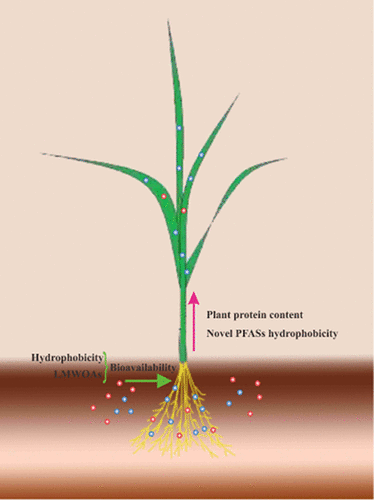当前位置:
X-MOL 学术
›
J. Agric. Food Chem.
›
论文详情
Our official English website, www.x-mol.net, welcomes your
feedback! (Note: you will need to create a separate account there.)
Bioavailability and Bioaccumulation of 6:2 Fluorotelomer Sulfonate, 6:2 Chlorinated Polyfluoroalkyl Ether Sulfonates, and Perfluorophosphinates in a Soil–Plant System
Journal of Agricultural and Food Chemistry ( IF 5.7 ) Pub Date : 2020-04-03 , DOI: 10.1021/acs.jafc.0c00542 Jian Zhou 1 , Min Li 1 , Jiaqian Li 1 , Zixuan Shao 1 , Yiman Liu 1 , Tiecheng Wang 1, 2 , Lingyan Zhu 1, 2, 3
Journal of Agricultural and Food Chemistry ( IF 5.7 ) Pub Date : 2020-04-03 , DOI: 10.1021/acs.jafc.0c00542 Jian Zhou 1 , Min Li 1 , Jiaqian Li 1 , Zixuan Shao 1 , Yiman Liu 1 , Tiecheng Wang 1, 2 , Lingyan Zhu 1, 2, 3
Affiliation

|
As emerging alternatives of legacy perfluoroalkyl substances, 6:2 fluorotelomer sulfonate (6:2 FTS), 6:2 chlorinated polyfluoroalkyl ether sulfonates (6:2 Cl-PFESA), and perfluorophosphinates (C6/C6 and C8/C8 PFPiAs) are supposed to be partitioned to soil and highly persistent in the environment. The uptake of novel per- and polyfluoroalkyl substances (PFASs) by plants represents a potential pathway for their transfer in the food chain. In this study, the bioavailability of these four novel PFASs in soil and the bioaccumulation characteristics in greenhouse-grown wheat (Triticum aestivum L.), maize (Zea mays L.), soybean (Glycine max L. Merrill), and pumpkin (Cucurbita maxima L.) were investigated. The results indicated that these novel PFASs with higher hydrophobicity were more easily sequestrated in soil, and the fractions extracted by methanol could well describe their bioavailability, which could be stimulated by low-molecular-weight organic acids at rhizospheric concentrations. A negative relationship was found between root soil concentration factors (RSCFs) and hydrophobicity (log Kow) of the target PFASs. This correlation was also found in the translocation factors (TF) from roots to shoots. Furthermore, the uptake and transfer of the target PFASs were regulated by the protein contents in plant roots and shoots.
中文翻译:

6:2 氟调聚物磺酸盐、6:2 氯化多氟烷基醚磺酸盐和全氟次膦酸盐在土壤-植物系统中的生物利用度和生物累积
作为传统全氟烷基物质的新兴替代品,6:2 氟调聚物磺酸盐 (6:2 FTS)、6:2 氯化多氟烷基醚磺酸盐 (6:2 Cl-PFESA) 和全氟次膦酸盐 (C6/C6 和 C8/C8 PFPiAs) 被认为是被分配到土壤中并在环境中高度持久。植物对新型全氟烷基物质和多氟烷基物质(PFAS)的吸收代表了它们在食物链中转移的潜在途径。在本研究中,这四种新型 PFAS 在土壤中的生物利用度以及温室种植的小麦 (Triticum aestivum L.)、玉米 ( Zea mays L.)、大豆 ( Glycine max L. Merrill) 和南瓜 ( Cucurbita ) 中的生物累积特性最大L.)进行了研究。结果表明,这些具有较高疏水性的新型PFAS更容易在土壤中隔离,甲醇提取的馏分可以很好地描述其生物利用度,而根际浓度的低分子量有机酸可以刺激其生物利用度。根部土壤浓度因子 (RSCF) 与目标 PFAS 的疏水性 (log K ow ) 之间存在负相关关系。从根到芽的易位因子(TF)也发现了这种相关性。此外,目标PFAS的吸收和转移受植物根和芽中蛋白质含量的调节。
更新日期:2020-04-06
中文翻译:

6:2 氟调聚物磺酸盐、6:2 氯化多氟烷基醚磺酸盐和全氟次膦酸盐在土壤-植物系统中的生物利用度和生物累积
作为传统全氟烷基物质的新兴替代品,6:2 氟调聚物磺酸盐 (6:2 FTS)、6:2 氯化多氟烷基醚磺酸盐 (6:2 Cl-PFESA) 和全氟次膦酸盐 (C6/C6 和 C8/C8 PFPiAs) 被认为是被分配到土壤中并在环境中高度持久。植物对新型全氟烷基物质和多氟烷基物质(PFAS)的吸收代表了它们在食物链中转移的潜在途径。在本研究中,这四种新型 PFAS 在土壤中的生物利用度以及温室种植的小麦 (Triticum aestivum L.)、玉米 ( Zea mays L.)、大豆 ( Glycine max L. Merrill) 和南瓜 ( Cucurbita ) 中的生物累积特性最大L.)进行了研究。结果表明,这些具有较高疏水性的新型PFAS更容易在土壤中隔离,甲醇提取的馏分可以很好地描述其生物利用度,而根际浓度的低分子量有机酸可以刺激其生物利用度。根部土壤浓度因子 (RSCF) 与目标 PFAS 的疏水性 (log K ow ) 之间存在负相关关系。从根到芽的易位因子(TF)也发现了这种相关性。此外,目标PFAS的吸收和转移受植物根和芽中蛋白质含量的调节。











































 京公网安备 11010802027423号
京公网安备 11010802027423号